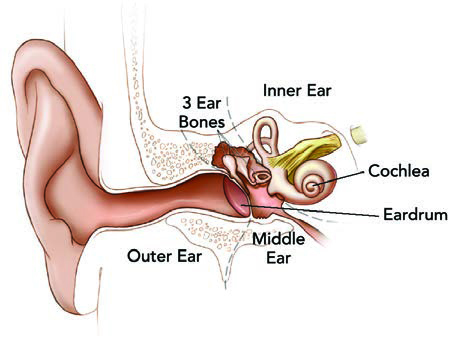

Noise above 70 dB over a prolonged period of time may start to damage your hearing. Loud noise above 120 dB can cause immediate harm to your ears.
Loud Noise Can Cause Hearing Loss Quickly or Over Time
Hearing loss can result from a single loud sound (like firecrackers) near your ear. Or, more often, hearing loss can result over time from damage caused by repeated exposures to loud sounds. The louder the sound, the shorter the amount of time it takes for hearing loss to occur. The longer the exposure, the greater the risk for hearing loss (especially when hearing protection is not used or there is not enough time for the ears to rest between exposures).
Here are some sources of loud noise that you may be exposed to. If you are repeatedly exposed to them over time, they can cause hearing loss.
Everyday Activities
Music from smartphones and personal listening devices, particularly when the volume is set close to the maximum
Fitness classes
Children’s toys
Events
Concerts, restaurants, and bars
Sporting events, such as football, hockey, and soccer games
Motorized sporting events, such as monster truck shows, stock car or road races, and snowmobiling
Movie theaters
Tools and More
Power tools
Gas-powered lawnmowers and leaf blowers
Sirens
Firearms
Firecrackers
Common Sources of Noise and Decibel Levels
Sound is measured in decibels (dB). A whisper is about 30 dB, normal conversation is about 60 dB, and a motorcycle engine running is about 95 dB. Noise above 70 dB over a prolonged period of time may start to damage your hearing.
Loud noise above 120 dB can cause immediate harm to your ears.
The table below shows dB levels and how noise from everyday sources can affect your hearing.
Everyday Sounds and Noises Average Sound Level (measured in decibels) Typical Response (after routine or repeated exposure)
Softest sound that can be heard 0
Sounds at these dB levels typically don’t cause any hearing damage.
Normal breathing 10
Ticking watch 20
Soft whisper 30
Refrigerator hum 40
Normal conversation, air conditioner 60
Washing machine, dishwasher 70 You may feel annoyed by the noise
City traffic (inside the car) 80–85 You may feel very annoyed
Gas-powered lawnmowers and leaf blowers 80-85 Damage to hearing possible after 2 hours of exposure
Motorcycle 95 Damage to hearing possible after about 50 minutes of exposure
Approaching subway train, car horn at 16 feet (5 meters), and sporting events (such as hockey playoffs and football games) 100 Hearing loss possible after 15 minutes
The maximum volume level for personal listening devices; a very loud radio, stereo, or television; and loud entertainment venues (such as nightclubs, bars, and rock concerts) 105–110 Hearing loss possible in less than 5 minutes
Shouting or barking in the ear 110 Hearing loss possible in less than 2 minutes
Standing beside or near sirens 120 Pain and ear injury
Firecrackers 140–150 Pain and ear injury
The time estimates listed in the “Typical Response” column are based on the NIOSH exchange rate of 3 dB. For more information, visit NIOSH’s website.
What Noises Cause Hearing Loss?
